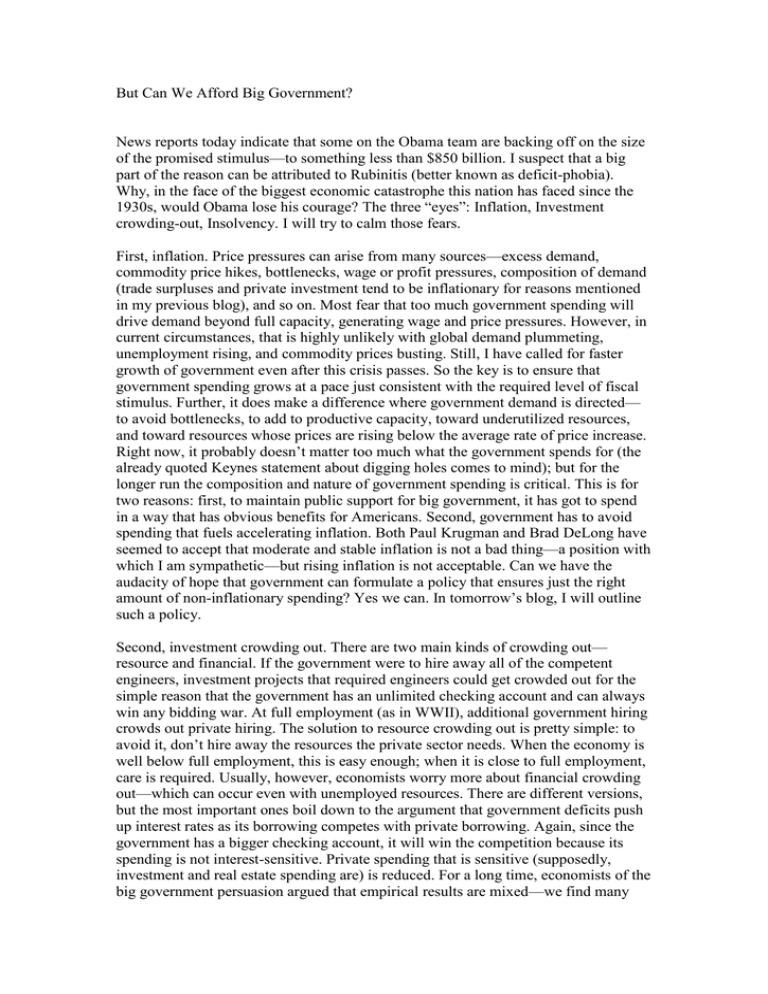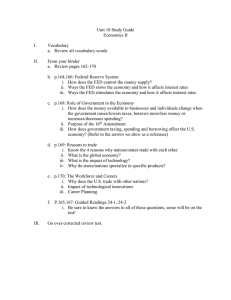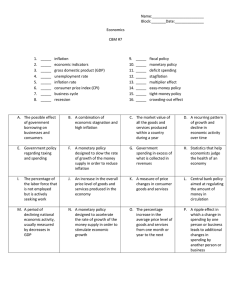But Can We Afford Big Government?
advertisement

But Can We Afford Big Government? News reports today indicate that some on the Obama team are backing off on the size of the promised stimulus—to something less than $850 billion. I suspect that a big part of the reason can be attributed to Rubinitis (better known as deficit-phobia). Why, in the face of the biggest economic catastrophe this nation has faced since the 1930s, would Obama lose his courage? The three “eyes”: Inflation, Investment crowding-out, Insolvency. I will try to calm those fears. First, inflation. Price pressures can arise from many sources—excess demand, commodity price hikes, bottlenecks, wage or profit pressures, composition of demand (trade surpluses and private investment tend to be inflationary for reasons mentioned in my previous blog), and so on. Most fear that too much government spending will drive demand beyond full capacity, generating wage and price pressures. However, in current circumstances, that is highly unlikely with global demand plummeting, unemployment rising, and commodity prices busting. Still, I have called for faster growth of government even after this crisis passes. So the key is to ensure that government spending grows at a pace just consistent with the required level of fiscal stimulus. Further, it does make a difference where government demand is directed— to avoid bottlenecks, to add to productive capacity, toward underutilized resources, and toward resources whose prices are rising below the average rate of price increase. Right now, it probably doesn’t matter too much what the government spends for (the already quoted Keynes statement about digging holes comes to mind); but for the longer run the composition and nature of government spending is critical. This is for two reasons: first, to maintain public support for big government, it has got to spend in a way that has obvious benefits for Americans. Second, government has to avoid spending that fuels accelerating inflation. Both Paul Krugman and Brad DeLong have seemed to accept that moderate and stable inflation is not a bad thing—a position with which I am sympathetic—but rising inflation is not acceptable. Can we have the audacity of hope that government can formulate a policy that ensures just the right amount of non-inflationary spending? Yes we can. In tomorrow’s blog, I will outline such a policy. Second, investment crowding out. There are two main kinds of crowding out— resource and financial. If the government were to hire away all of the competent engineers, investment projects that required engineers could get crowded out for the simple reason that the government has an unlimited checking account and can always win any bidding war. At full employment (as in WWII), additional government hiring crowds out private hiring. The solution to resource crowding out is pretty simple: to avoid it, don’t hire away the resources the private sector needs. When the economy is well below full employment, this is easy enough; when it is close to full employment, care is required. Usually, however, economists worry more about financial crowding out—which can occur even with unemployed resources. There are different versions, but the most important ones boil down to the argument that government deficits push up interest rates as its borrowing competes with private borrowing. Again, since the government has a bigger checking account, it will win the competition because its spending is not interest-sensitive. Private spending that is sensitive (supposedly, investment and real estate spending are) is reduced. For a long time, economists of the big government persuasion argued that empirical results are mixed—we find many cases of rising budget deficits and falling interest rates, and falling budget deficits and rising interest rates—so even if the theory is correct, the real world results don’t necessarily comply. But it is simpler than that: the theory is just plain wrong. All central bankers everywhere now admit that they target the short-term interest rate; and they hit their targets within a self-determined margin of error. It makes no difference whether the budget deficit reaches a Japan-like 10% of GDP (with zero interest rates), or a US-like 25% of GDP (during WWII, with interest rates at 3/8 of one percent), or a US-like budget surplus of 2% of GDP (under Clinton—accompanied by rising rates!). The Fed determines the short-term interest rate. Period. Yes, it might raise the rate in response to budget deficits—but that is a policy decision. If Congress doesn’t like that, it should change the instructions it provides to the Fed. There are two further points to be made here; and, sorry, they are for the more technically inclined. The central bank operates with an overnight rate target, but it can choose the maturity it likes—indeed, Bernanke’s Fed is now experimenting with longer maturity targets under cover of the label “quantitative easing”. This seems important because one objection is that the Treasury issues longer-term debt and while it is true that the central bank sets overnight rates, longer rates are “market determined” and crowding-out in the longer maturity markets is still possible. However, the maturity of Treasury debt is a policy variable—and there is no reason in principle why the Treasury could not operate only at the short end (even overnight debt!) to avoid crowding-out. For those who are still skeptical, let me move to the second, more important, point. Government spends by crediting bank accounts (bank deposits go up, and their reserves are credited by the Fed). All else equal, this generates excess reserves that are offered in the overnight interbank lending market (fed funds in the US) putting downward pressure on overnight rates. Let me repeat that: government spending pushes interest rates down. When they fall below the target, the Fed sells bonds to drain the excess reserves—pushing the overnight rate back to the target. Continuous budget deficits lead to continuous open market sales, causing the NY Fed to call on the Treasury to soak up reserves through new issues of bonds. The purpose of bond sales by the Fed or Treasury is to substitute interestearning bonds for undesired reserves—to allow the Fed to hit its interest rate target. (In the old days, these reserves earned no interest; Bernanke has changed that, effectively eliminating the difference between very short-term Treasuries and bank reserves. It also entirely eliminates the need to issue Treasuries—but that is a topic for another day.) We conclude: government deficits do not exert upward pressure on interest rates—quite the contrary, they put downward pressure that is relieved through bond sales. On to the final phobia: insolvency. Let me state the conclusion first: a sovereign government that issues its own floating rate currency can never become insolvent in its own currency. (While such a currency is often called “fiat”, that is somewhat misleading for reasons I won’t discuss here—I prefer the term “sovereign currency”.) The US Treasury can always make all payments as they come due—whether it is for spending on goods and services, for social spending, or to meet interest payments on its debt. While analogies to household budgets are often made, these are completely erroneous. I do not know any households that can issue Treasury coins or Federal Reserve Notes (I suppose some try occasionally, but that is a dangerous business). To be sure, government does not really spend by direct issues of coined nickels. Rather, it spends by crediting bank accounts. It taxes by debiting them. When its credits to bank accounts exceeds its debits to them, we call that a budget deficit. The accounting and operating procedures adopted by the Treasury, the Fed, special deposit banks, and regular banks are complex, but they do not change the principle: government spending is accomplished by crediting bank accounts. Government spending can be too big (beyond full employment), it can misdirect resources, and it can be wasteful or undesirable, but it cannot lead to insolvency. Constraining government spending by imposing budgets is certainly desirable. We want to know in advance what the government is planning to do, and we want to hold it accountable; a budget is one lever of control. At this point, it is impossible to know how much additional government spending will be required to get us out of this deep recession. Whether the Obama team finally settles on $850 billion worth of useful projects, or $1 trillion, voters have the right to expect that the spending is wellplanned and that the projects are well-executed. But the budgets ought to be set with regard to results desired and competencies to execute plans—not out of some preconceived notion of what is “affordable”. Our federal government can afford anything that is for sale in terms of its own currency. The trick is to ensure that it spends enough to produce sustainable growth and other desired outcomes while at the same time ensuring that its spending does not have undesirable outcomes such as fueling inflation or taking away resources that could be put to better use by the private sector. Next time: a policy proposal.


